Sri Pada: Shrouded in legend and history
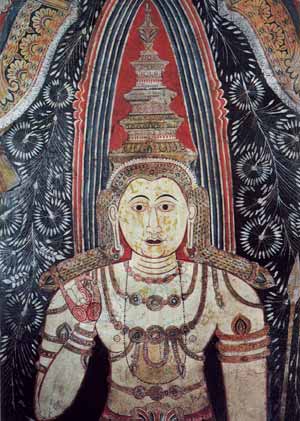
|
|
Saman Deviyo as depicted at Kelaniya Vihara
|
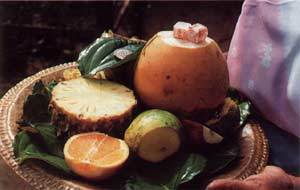
|
|
Offering brought to Saman Devale, Ratnapura
|
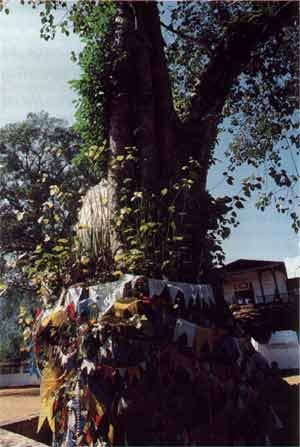 |
|
Offerings left at the Bo tree at Maha Saman Devale, Ratnapura
|
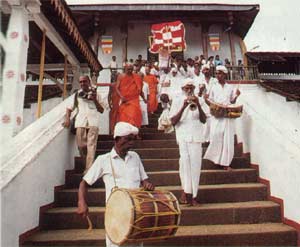
|
|
Saman Deviyo statue being brought in procession from Maha Saman Devale to Sri Pada at the beginning of the pilgrimage season
|
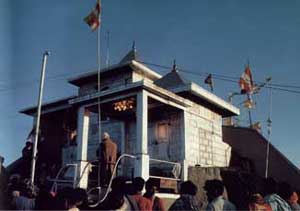
|
|
Building that houses the holy footprint at the summit of Sri Pada
|
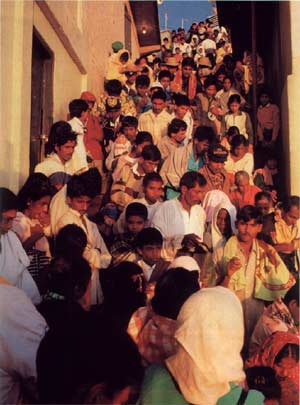
|
|
On a poya (full moon) day in the pilgrimage season, the crowds on the steps to the peak can be so great that pilgrims may stand in a stationary queue for hours.
|
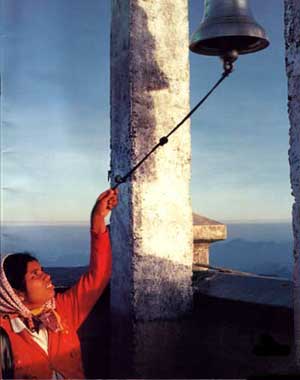
|
|
Next to the holy footprint hangs a bell that each pilgrim is
entitled to ring as many times as he has climbed the sacred mountain.
|
by Aryadasa Ratnasinghe
"In that yle is a great Mountayne and thei of the Countrey seym, that Adam and Eve wepten upon that Mount a hundred Zeer whan thai weren driven out of Paradys."
- Sir John Maundeville.
The pilgrim season to the holy mountain Sri Pada (also known as Samantakuta, Samanhela, Samangira, Samanalakanda and Samanalagira), begins annually on the 'Unduvap' fullmoon day in December and ends on the 'Vesak' fullmoon day in May. During this open semester, pilgrims ascend the mountain to pay homage to the sacred footmark, which is considered holy by the Buddhists, Christians, Hindus and Moslems alike, according to their individual beliefs. Therefore, Sri Pada is the only mountain in the world receiving benefactions and veneration of devotees belonging to different faiths.
The summit of the mountain is a small plateau, and according to measurements made by Lieut. Malcolm (the first European to ascend the mountain in 1816), "it is 74 ft. in length and 24 ft. in breadth," the total area being 1,776 sq. ft. On the summit there is a huge boulder, about 8 ft. high., atop which is found the sacred footmark. According to mythical conception woven into the fabric of native folklore, the real impression of the Foot lies under the boulder, on a blue sapphire. To prevent it from sacrilegious profanation, god Sakra had covered it with the boulder.
"The footmark is a superficial flow 68 in. long, and 31 in. and 29 in. wide at the toes and the heel respectively. It is ornamented with a margin of brass and studded with few gems. The cavity bears some coarse resemblance to a human foot, but the size is gigantic, and seems partly natural and partly artificial. There are little raised partitions to represent the interstices between toes." So says Dr. John Davy who had ascended the mountain in 1817. Landmark
This hallowed mountain, shrouded in legend and history, is situated 16 km. North-East of Ratnapura. It rises abruptly from the lower valley, to an altitude of 2,243m. (7,360 ft.) above sea level, and offers an unobstructed view over land and sea.
The mountain was the landmark of the ancient sea-faring Arabs, who came to Sri Lanka, to trade in gems, spices, ivory etc., and they, having sighted the conical mountain miles off shore, prayed to God for having brought them safely to the island.
They believed that atop this mountain lay the sepulchre of Adam (the first parent of the human race).
The famous itinerant Arab pilgrim Ibn Batuta alias Abu Abdullah Mohammed (1304-1377), had ventured to reach the summit of the holy mountain via Ratnapura, trekking the way by the banks of the Kalu-ganga, which discharges its confluence into the sea at Kalutara, having commenced his journey from Barberyn (Beruwala). Before him, the renowned Venetian merchant and traveller, Marco Polo (125401324), too had ascended the mountain to pay homage to the glorious Foot of Adam, on his way from China in 1292, before returning to Venice. It was while in China that he had come to know about the sacred footmark from Kublai Khan, the first Emperor of the Yuan dynasty in China.
Buddhists believe that the footmark on the summit of Sri Pada is that of Buddha, who, during his third visit to Kelaniya, 2,580 year ago, kept the imprint of his left foot thereon as a relict worthy of veneration. He did so at the kind request of god Saman, the tutelary deity of the mountain wilderness, whose divine eye is supposed to cast upon Deraniyagala, Boltumbe, Ellakkala, Nivitigala and the mountain Benasamanalagala.
Seductive
The Christians believe that Adam, after being expelled from the Garden of Eden (Paradise), for eating the forbidden fruit, fell upon earth, and according to legend, had fallen on top of the mountain, where he is believed to have stood on one foot for one thousand years, to expiate his sin committed against the Creator, by eating the seductive fruit, despite warning given. This long ordeal had left the print of his foot on the mountain.
The Portuguese, who came to Sri Lanka in 1505, called the mountain Pico de Adam (anglicised Adam's Peak). They held the belief that St. Thomas the Doubter, having come to India, baptised Gondophorus, the Indo-Parthian king, and after leaving his footmark on the mountain, had ascended to Heaven. According to Christian view, he is not the author of the Gospel of St. Thomas (the logia containing early collections of sayings ascribed to Jesus). St. Thomas the Doubter was a disciple and a step-brother of Jesus, the most prominent figure in the Gospel of St.
John, where he is also known as Didymus, and portrayed as doubting the Resurrection of Christ, until he touched the wounds of the risen Christ. Early Christian tradition describes him as a missionary and a martyr in India.
The belief of the Moslems is similar to that of the Christians based on the Old Testament. They call the mountain 'Adam-malai' (Mount of Adam) in view of their belief that atop the mountain lies the sepulchre of Adam. The Hindus believe that the footmark is of Lord Siva, the third godhead of the Hindu 'Trimoorti' (the Holy Triad), the other two being Brahma and Vishnu. The god is supposed to have settled on the summit to shed his divine light upon mankind. Hence they call the mountain 'Sivanolipadam' (Foot of Siva's Light). The votaries of god Siva ascend the mountain beseeching divine help and providence to be born in the celestial abode, i.e., Mount Kailas.
Apostate
The apostate Rajasinha I (1581-1592), in order to overcome his fear of patricidal sin for killing his father, the King Mayadunne of Sitawaka, and on the advice of the sectarian priest Arittakivendu Perumal, assigned the administration of the holy mountain to 'Andis' (a non-braminical Saiva sect) from South India. They collected a considerable revenue on offerings made to the sacred Foot, by way of gold, gems, jewellery, silver, cash, clothing etc. During the close semester, from June to November, these 'Andis' clad in yellow clothing, went from door to door, collecting offerings, on the pretext of developing and improving the paths leading to the summit via Hatton and Ratnapura, intoning the words "Siripade galpadi bandinata sammadam" (offerings for the construction of stone steps to Sri Pada). Later, King Kirti Śrī Rajasinha (1747-1781), revoked the royal proclamation, and appointed Ven. Welivitiye Saranankara Sangharaja Maha Thera, to look after Buddhist interests of the holy mountain.
The open semester begins with the removal of the statues of God Saman, the replica of his divine white elephant and other sacred paraphernalia, lying secured at the Galpottawela Raja Maha Vihara at Pelmadulla, built by king Kirti Śrī Rajasinha. According to ritual, the incumbent priest of Sri Pada and the working committee, composed of Buddhist clergy and laity, enter the shrine room of the devale, and a day
In the old days, the procession took the Ratnapura route, but now a motorcade leaves to the summit along the Hatton path via Ratnapura, Avissawella, Yatiyantota, Kitulgala, Ginigathena, Hatton, Dickoya and Maskeliya, terminating at the Delhousie bazaar (Nallatanniya) where vehicular transport facilities cease. As the fullmoon poya day dawns, they reach the summit and, after attending to formal rituals, the 'kapurala' places the statues dedicated to the God inside a niche below the footmark.
The two historic paths to the summit are the Hatton path via Maskeliya and the Ratnapura path via Kuruwita.
The Hatton path was, in the ancient days, known as the Rajamawatha, along which most kings had ventured to the summit via Ambagamuwa, Kehelgamuwa, Horakada, Dagampitiya, Makulumulla, Hangarapitiya and Seetagangula (parent stream of the Mahaveli-ganga), from where the actual ascent begins. This route came into prominence during the Gampola period (1347-1412), which followed the Mahaveli-ganga from Gangasiripura (now Gampola) and the first king to go on pilgrimage to Sri Pada, on this route, was Bhuvanekhabahu IV (1347-1352).
Pilgrims
The oldest route was the Ratnapura path, via Gilimale, Eratna, Kuruwita, Malwala and Palabaddala, to Seetagangula (parent stream of the Kaluganga). Even today, pilgrims consider this route as the difficult path, and highly infested with leeches due to dampness of the climate. Pilgrims have to toil up and down narrow passes up to Palabaddala, the last inhabited station en route.
In most places the path is narrow, rugged and rocky and densely wooded. This route came into prominence during the Polonnaruwa period and the first king who went on pilgrimage was Vijayabahu I (1058-1114).
He built rest camps for pilgrims along the path. The Ambagamuwa rock edict and the Panakaduwa copper plate bear testimony to his munificence. However, it was King Kirti Nissankamalla (1187-1196) who went on pilgrimage with his fourfold army.
Seetagangula (the torrent of icy water) is an important landmark en route to the summit. It rushes from the woody height down a stream obstructed by masses of rock formation. Here, the pilgrims, after performing their ablutions, make a frugal repast, some rest for awhile chewing betel, and after observing 'pansil' and making obeisance to God Saman, and after trying 'panduru' (a coin wrapped in a clean white cloth as an offering for protection) they begin to ascend the mountain to reach the summit, with a break at the place called 'Indikatupahana', a popular rest camp. From this point, a long line of concrete steps leads to the summit.
In the old days, pilgrims ascended the mountain by stepping upon bare rock surface and clinging on to chains fitted to iron posts drilled into the rocky floor. John Still, in his book Jungle Tide, says how once a batch of pilgrims, fell into the precipice below when the railing they were holding on to broke loose, probably due to weight.
The most dangerous part of the climb was the point known as 'Mahagiridambe' where the pilgrims exposed to heavy wind were at risk of being carried away.
Pilgrims try to reach the summit before dawn to view the grand phenomenon known as the 'ira-sevaya' (the effulgence of the rising sun) puncturing the eastern horizon, like a ball of fire, casting a shadow of the mountain to fall on to the valley in the opposite direction, like a cone. The 'ira sevaya' is considered to mean the worship of the foot by the sun-god.
There is a huge brass lamp atop the mountain that keeps burning day and night, during the open semester, and it was an offering made by king Wickremabahu III (1360-1375). The oil from this lamp is taken away by pilgrims for medicinal purposes.
Courtesy: The Sunday Observer of 24 December, 2000.